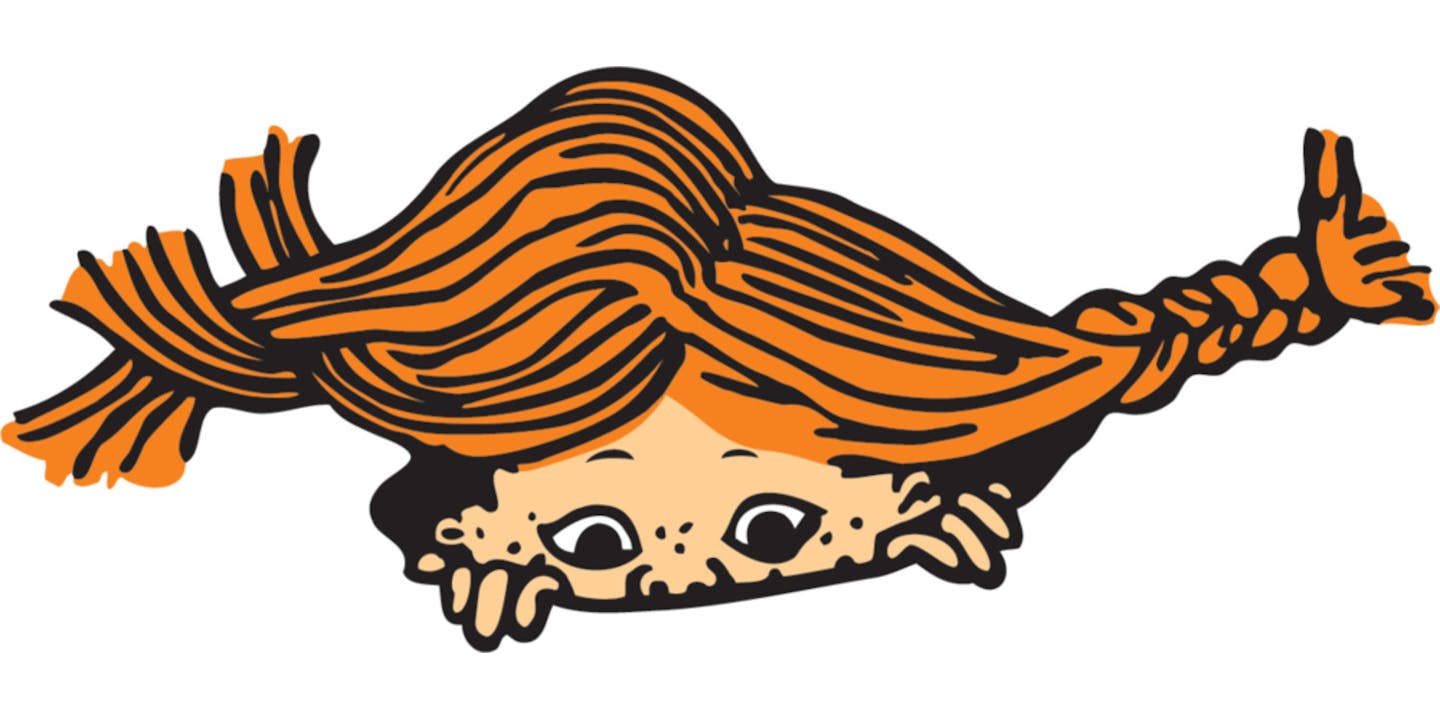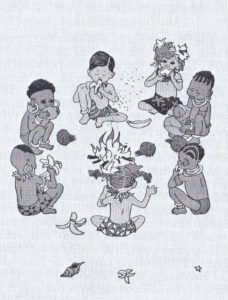
https://www.astridlindgren.com/de/figuren/pippi-langstrumpf
Astrid Lindgren’s Pippi is a well-known child heroine who has for the last 76 years inspired many children all around the world and still does to this day. But despite Pippi’s positive influence on children and her unquestionably important role in the gender discourse in children’s literature, Lindgren’s books contain some colonial and racist aspects. I would like to give a brief overview of some of those aspects by showing a couple examples and analysing them from a postcolonial perspective. With this short analysis I want to demonstrate that these aspects have to be seen in their historical context and could be seen as a stylistic device to criticize the hegemonic society.
One of the most obvious racist features in the language of Pippi Långstrump is the description of Pippi’s father. When Pippi goes to school with Annika and Tommy, she introduces herself and mentions her father:
Pippilotta Viktualia Rullgardina Krusmynta Efraimsdotter Långstrump, dotter till kapten Efraim Långstrump, fordom havens skräck, numera n*kung [Censored by N.B.[1]] (Lindgren, Pippi Långstrump 57). Pippilotta Victualia Rollgardina Peppermint Efraim’s Daughter Longstocking, daughter of captain Longstocking, formerly the terror of the seas, now n*king [Translation
by N.B.].
The term “n*kung” is highly problematic and would no longer be accepted today. The use of the N-word alone stands in connection with colonialism and slave trade and puts the described people in an inferior position and the describers in a position of power. The combination with the term “king” reinforces this connotation even more. However, the racist term has to be seen in the publication’s historical context. The N-word was not condemned in 1945 the way it rightfully is today. Under the relevant entry in Svensk Ordbok from 2009 one finds the following explanation to the word:
N* var länge ett ord som inte på något sätt uppfattades som nedsättande. […] Även om användning av ordet n* kan vara obetänksam bör den dock inte utan vidare stämplas som rasistisk [censored N.B.] (Svensk Ordbok). N* was for a long time a word that was in no way perceived as derogatory. […] Although the use of the word n* can be inconsiderate it should not just be classified as racist [Translation N.B.].
The entry on the use of the N-word shows that the term was not always perceived as racist. With this background knowledge it can be assumed that the word in the book was a product of its time. However, it also demonstrates an unreflected usage of racist language. The term of the original text was later replaced with “söderhavskung” (king of the south-sea) and the passage quoted earlier reads as follows:
Pippilotta Viktualia Rullgardina Krusmynta Efraimsdotter Långstrump, dotter till kapten Efraim Långstrump, fordom havens skräck, numera söderhavskung (Lindgren, Boken om Pippi Långstrump 25–26).
Racist traits can also be found in Ingrid Vang Nyman’s illustrations of the original books (Jung 293). Konstanze Jung examines different drawings of the children of Kurrekurreduttön from a postcolonial perspective and notes that they are drawn in a stereotypical, exaggerated way (Jung 296). In the drawing below, one can see Pippi, Annika and Tommy, who are sitting together, with some children of the island around a fire, eating bananas and coconuts (Jung 296). The typical fruits alone are a stereotype, but the islanders are also wearing jewellery made from animal-teeth. In the discussed picture, there is no significant difference in the depiction of the boys and girls, whereas Pippi and Annika look very different from Tommy (Jung 296). For example, Pippi and Annika have long hair adorned with flowers while Tommy has short hair. The children of the island meanwhile all have similar-looking hair. This type of illustration is racist and shows the children in the stereotypical light of the “uncivilized savage” (Jung 296). The fact that there is no obvious difference between the boys and the girls of the island, while Pippi, Annika and Tommy can easily be differentiated, could be an indication of a colonial point of view. One could say the depiction implies that it is not as important to differentiate between the inhabitants of the island as it is between the three children from Sweden.

Jung argues that while the drawings are racist, they are also very exaggerated and therefore can be seen as a caricature of those racist stereotypes (Jung 298). She claims that precisely these illustrations and the exaggerated stereotypical characters in the books destroy the clichés again (Jung 298). Furthermore, she claims that this can be seen as a way to subvert established power structures and to criticize society (Jung 298). Jung’s approach seems excusatory at first glance but also suggests an interesting analysation of the pictures.
With Jung’s position in mind, I would like to point out another detail in relation to colonialism. When Pippi, Annika and Tommy play with the children from the island, Pippi talks about the schools in Sweden and multiplication (Lindgren, Boken om Pippi Långstrump 126–127). Pippi wants to play school with the children, Annika and Tommy and explains math and multiplication to her new friends (126–127). Without more information, this scene could be understood as a typical colonial situation, where the colonized are educated by the colonizers. The fact that Pippi does not understand anything about math herself and always says “pluttifikation” instead of “multiplikation”, however, puts the scene in a comical light. The whole “math lesson” can be seen as a parody of a real colony and the book can thus be read as taking an anti-colonial stance. In other words, this scene could, with Jung’s argumentation, also be seen as an undermining and criticism of colonialism.
Certain other scenes in Boken om Pippi Långstrump would support this point of view. When Pippi, her friends and her father come to Kurrekurreön, there are two thrones waiting for them (Lindgren, Boken om Pippi Långstrump 123). The fact that there is a throne puts the scene in a colonial light and Pippi and her father in a colonial context. At first the two behave like „typical“ colonizers when Pippi and her father sit on their thrones. But when Pippi sees that the children of the island are bowing to her, she leaves the throne and wants to play with the children (Lindgren, Boken om Pippi Långstrump 123–124). When the children explain to Pippi that they bow to her because she is a princess, Pippi refuses to sit on the throne any longer and declares that she does not care about the throne and that she is first and foremost Pippi and not a princess (Lindgren, Boken om Pippi Långstrump 125). This statement does not fit into the colonial setting and questions the division into princess and subjects or colonizers and colonized. Pippi’s reaction shows that the book can not simply be assigned a colonial perspective and it sometimes even questions the established power-structures. However, the book always remains dependent on the colonial discourse.
As one can see, the topic of colonial and racist structures in Lindgren’s books about Pippi is not easy to summarize. On the one hand there are clearly some features regarding racism and colonialism in the books. On the other hand, the stories of Pippi also contain aspects, which, through irony and exaggeration, question the established stereotypes and the division into the powerful and the powerless. Therefore in certain scenes an anti-colonial attitude can be identified.
[1] Because of political correctness the N-word will always be censored.
References:
Primary literature:
Lindgren, Astrid. Boken om Pippi Långstrump. Eboksproduktion Publit 2015.
Lindgren, Astrid. Pippi Långstrump. Ljungföretagen: Örebro 1969.
Secondary literature:
Jung, Konstanze. “Pippi Langstrumpf und der Rassismusdiskurs. Überlegungen zur Wirkungsgeschichte im interkulturellen Kontext und zu ausgewählten literaturpädagogischen Konzepten. ” Astrid Lindgren – Werk und Wirkung. Internationale und interkulturelle Aspekte. Edited by Blume, Svenja et al., Peter Lang GmbH 2009, pp. 287–306.
Svensk Ordbok. https://svenska.se/so/?id=35562&pz=7 (03.01.2021).
Picture 1: https://www.astridlindgren.com/de/figuren/pippi-langstrumpf
Picture 2: Illustration drawn by Ingrid Vang Nyman in Lindgren, Astrid. Pippi fährt nach Taka-Tuka-Land. Hamburg 2005.
